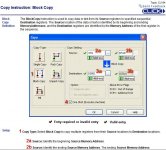Hello everyone,
I am new to the forum and have only basic PLC experience. I have an application where I need to use a CLICK PLC to control a roller conveyor to direct boxes to one of four lanes using three pop up diverters.
There is no way of monitoring conveyor position (the conveyor is at a constant speed), but there are photo eyes located at each of the three diverters for box position sensing. The time/distance between boxes is variable and it is possible for up to 5 boxes to be introduced before one would reach the last lane. Lane selection will be manual input from one of four push-buttons at the start of the conveyor.
I have attempted to research various methods of handling the box queue(shift register and FIFO) and have only managed to confuse myself. Also, I know that the Click PLC instruction set is somewhat limited. I was hoping that someone could point me in the right direction.
Thank you!
I am new to the forum and have only basic PLC experience. I have an application where I need to use a CLICK PLC to control a roller conveyor to direct boxes to one of four lanes using three pop up diverters.
There is no way of monitoring conveyor position (the conveyor is at a constant speed), but there are photo eyes located at each of the three diverters for box position sensing. The time/distance between boxes is variable and it is possible for up to 5 boxes to be introduced before one would reach the last lane. Lane selection will be manual input from one of four push-buttons at the start of the conveyor.
I have attempted to research various methods of handling the box queue(shift register and FIFO) and have only managed to confuse myself. Also, I know that the Click PLC instruction set is somewhat limited. I was hoping that someone could point me in the right direction.
Thank you!



